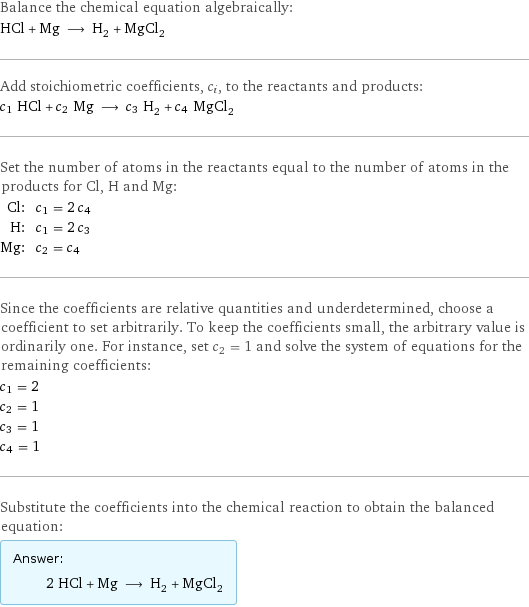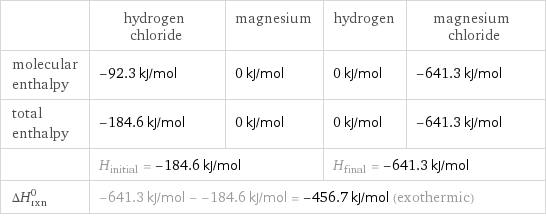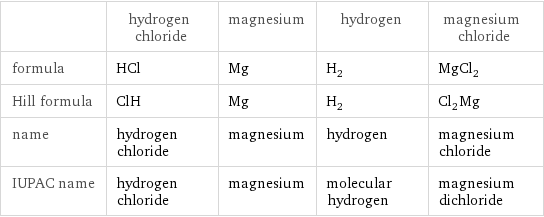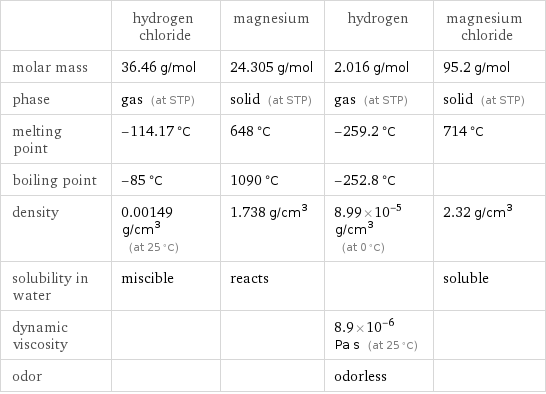Input interpretation

HCl (hydrogen chloride) + Mg (magnesium) ⟶ H_2 (hydrogen) + MgCl_2 (magnesium chloride)
Balanced equation

Balance the chemical equation algebraically: HCl + Mg ⟶ H_2 + MgCl_2 Add stoichiometric coefficients, c_i, to the reactants and products: c_1 HCl + c_2 Mg ⟶ c_3 H_2 + c_4 MgCl_2 Set the number of atoms in the reactants equal to the number of atoms in the products for Cl, H and Mg: Cl: | c_1 = 2 c_4 H: | c_1 = 2 c_3 Mg: | c_2 = c_4 Since the coefficients are relative quantities and underdetermined, choose a coefficient to set arbitrarily. To keep the coefficients small, the arbitrary value is ordinarily one. For instance, set c_2 = 1 and solve the system of equations for the remaining coefficients: c_1 = 2 c_2 = 1 c_3 = 1 c_4 = 1 Substitute the coefficients into the chemical reaction to obtain the balanced equation: Answer: | | 2 HCl + Mg ⟶ H_2 + MgCl_2
Structures

+ ⟶ +
Names

hydrogen chloride + magnesium ⟶ hydrogen + magnesium chloride
Reaction thermodynamics
Enthalpy

| hydrogen chloride | magnesium | hydrogen | magnesium chloride molecular enthalpy | -92.3 kJ/mol | 0 kJ/mol | 0 kJ/mol | -641.3 kJ/mol total enthalpy | -184.6 kJ/mol | 0 kJ/mol | 0 kJ/mol | -641.3 kJ/mol | H_initial = -184.6 kJ/mol | | H_final = -641.3 kJ/mol | ΔH_rxn^0 | -641.3 kJ/mol - -184.6 kJ/mol = -456.7 kJ/mol (exothermic) | | |
Equilibrium constant
![Construct the equilibrium constant, K, expression for: HCl + Mg ⟶ H_2 + MgCl_2 Plan: • Balance the chemical equation. • Determine the stoichiometric numbers. • Assemble the activity expression for each chemical species. • Use the activity expressions to build the equilibrium constant expression. Write the balanced chemical equation: 2 HCl + Mg ⟶ H_2 + MgCl_2 Assign stoichiometric numbers, ν_i, using the stoichiometric coefficients, c_i, from the balanced chemical equation in the following manner: ν_i = -c_i for reactants and ν_i = c_i for products: chemical species | c_i | ν_i HCl | 2 | -2 Mg | 1 | -1 H_2 | 1 | 1 MgCl_2 | 1 | 1 Assemble the activity expressions accounting for the state of matter and ν_i: chemical species | c_i | ν_i | activity expression HCl | 2 | -2 | ([HCl])^(-2) Mg | 1 | -1 | ([Mg])^(-1) H_2 | 1 | 1 | [H2] MgCl_2 | 1 | 1 | [MgCl2] The equilibrium constant symbol in the concentration basis is: K_c Mulitply the activity expressions to arrive at the K_c expression: Answer: | | K_c = ([HCl])^(-2) ([Mg])^(-1) [H2] [MgCl2] = ([H2] [MgCl2])/(([HCl])^2 [Mg])](../image_source/e78553af4c64a89257bcf448dde3f2be.png)
Construct the equilibrium constant, K, expression for: HCl + Mg ⟶ H_2 + MgCl_2 Plan: • Balance the chemical equation. • Determine the stoichiometric numbers. • Assemble the activity expression for each chemical species. • Use the activity expressions to build the equilibrium constant expression. Write the balanced chemical equation: 2 HCl + Mg ⟶ H_2 + MgCl_2 Assign stoichiometric numbers, ν_i, using the stoichiometric coefficients, c_i, from the balanced chemical equation in the following manner: ν_i = -c_i for reactants and ν_i = c_i for products: chemical species | c_i | ν_i HCl | 2 | -2 Mg | 1 | -1 H_2 | 1 | 1 MgCl_2 | 1 | 1 Assemble the activity expressions accounting for the state of matter and ν_i: chemical species | c_i | ν_i | activity expression HCl | 2 | -2 | ([HCl])^(-2) Mg | 1 | -1 | ([Mg])^(-1) H_2 | 1 | 1 | [H2] MgCl_2 | 1 | 1 | [MgCl2] The equilibrium constant symbol in the concentration basis is: K_c Mulitply the activity expressions to arrive at the K_c expression: Answer: | | K_c = ([HCl])^(-2) ([Mg])^(-1) [H2] [MgCl2] = ([H2] [MgCl2])/(([HCl])^2 [Mg])
Rate of reaction
![Construct the rate of reaction expression for: HCl + Mg ⟶ H_2 + MgCl_2 Plan: • Balance the chemical equation. • Determine the stoichiometric numbers. • Assemble the rate term for each chemical species. • Write the rate of reaction expression. Write the balanced chemical equation: 2 HCl + Mg ⟶ H_2 + MgCl_2 Assign stoichiometric numbers, ν_i, using the stoichiometric coefficients, c_i, from the balanced chemical equation in the following manner: ν_i = -c_i for reactants and ν_i = c_i for products: chemical species | c_i | ν_i HCl | 2 | -2 Mg | 1 | -1 H_2 | 1 | 1 MgCl_2 | 1 | 1 The rate term for each chemical species, B_i, is 1/ν_i(Δ[B_i])/(Δt) where [B_i] is the amount concentration and t is time: chemical species | c_i | ν_i | rate term HCl | 2 | -2 | -1/2 (Δ[HCl])/(Δt) Mg | 1 | -1 | -(Δ[Mg])/(Δt) H_2 | 1 | 1 | (Δ[H2])/(Δt) MgCl_2 | 1 | 1 | (Δ[MgCl2])/(Δt) (for infinitesimal rate of change, replace Δ with d) Set the rate terms equal to each other to arrive at the rate expression: Answer: | | rate = -1/2 (Δ[HCl])/(Δt) = -(Δ[Mg])/(Δt) = (Δ[H2])/(Δt) = (Δ[MgCl2])/(Δt) (assuming constant volume and no accumulation of intermediates or side products)](../image_source/35c418d3719533304f8ebc3e809732ea.png)
Construct the rate of reaction expression for: HCl + Mg ⟶ H_2 + MgCl_2 Plan: • Balance the chemical equation. • Determine the stoichiometric numbers. • Assemble the rate term for each chemical species. • Write the rate of reaction expression. Write the balanced chemical equation: 2 HCl + Mg ⟶ H_2 + MgCl_2 Assign stoichiometric numbers, ν_i, using the stoichiometric coefficients, c_i, from the balanced chemical equation in the following manner: ν_i = -c_i for reactants and ν_i = c_i for products: chemical species | c_i | ν_i HCl | 2 | -2 Mg | 1 | -1 H_2 | 1 | 1 MgCl_2 | 1 | 1 The rate term for each chemical species, B_i, is 1/ν_i(Δ[B_i])/(Δt) where [B_i] is the amount concentration and t is time: chemical species | c_i | ν_i | rate term HCl | 2 | -2 | -1/2 (Δ[HCl])/(Δt) Mg | 1 | -1 | -(Δ[Mg])/(Δt) H_2 | 1 | 1 | (Δ[H2])/(Δt) MgCl_2 | 1 | 1 | (Δ[MgCl2])/(Δt) (for infinitesimal rate of change, replace Δ with d) Set the rate terms equal to each other to arrive at the rate expression: Answer: | | rate = -1/2 (Δ[HCl])/(Δt) = -(Δ[Mg])/(Δt) = (Δ[H2])/(Δt) = (Δ[MgCl2])/(Δt) (assuming constant volume and no accumulation of intermediates or side products)
Chemical names and formulas

| hydrogen chloride | magnesium | hydrogen | magnesium chloride formula | HCl | Mg | H_2 | MgCl_2 Hill formula | ClH | Mg | H_2 | Cl_2Mg name | hydrogen chloride | magnesium | hydrogen | magnesium chloride IUPAC name | hydrogen chloride | magnesium | molecular hydrogen | magnesium dichloride
Substance properties

| hydrogen chloride | magnesium | hydrogen | magnesium chloride molar mass | 36.46 g/mol | 24.305 g/mol | 2.016 g/mol | 95.2 g/mol phase | gas (at STP) | solid (at STP) | gas (at STP) | solid (at STP) melting point | -114.17 °C | 648 °C | -259.2 °C | 714 °C boiling point | -85 °C | 1090 °C | -252.8 °C | density | 0.00149 g/cm^3 (at 25 °C) | 1.738 g/cm^3 | 8.99×10^-5 g/cm^3 (at 0 °C) | 2.32 g/cm^3 solubility in water | miscible | reacts | | soluble dynamic viscosity | | | 8.9×10^-6 Pa s (at 25 °C) | odor | | | odorless |
Units
